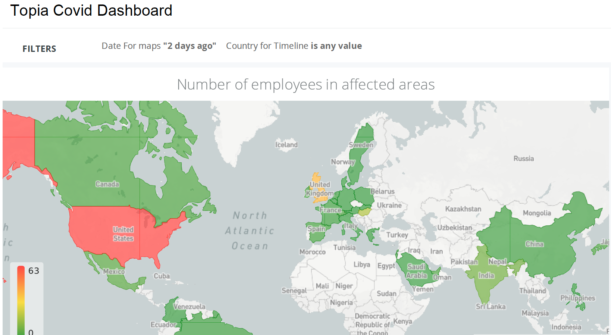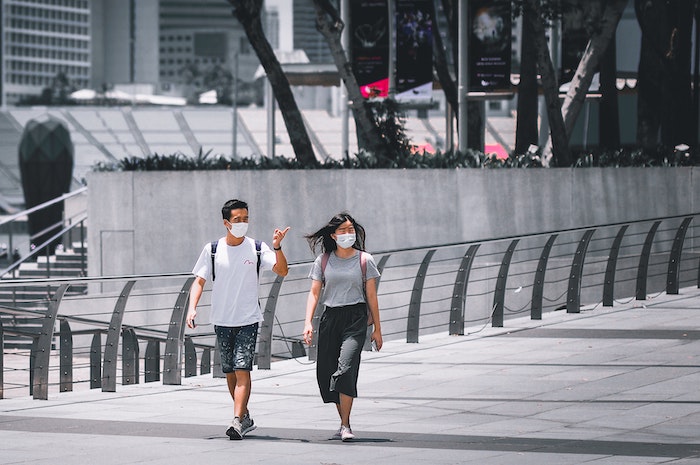
How does global talent mobility function during a pandemic?
Topia delivers the world’s leading Global Talent Mobility platform which enables organizations to mobilize thousands of employees around the world. The COVID-19 pandemic has grounded even the most mobile talent. Where do we go from here?
Paradoxically, over the last few weeks, Topia has been at the forefront of actively curtailing the movement of people. We’re helping customers cancel their planned assignments. We’ve mandated work from home for our employees. No travel. No large gatherings. All in support of curtailing the spread of this deadly virus.
As a company that thrives on the free movement of talent — and particularly since we just acquired a business travel compliance company — you’re probably wondering- what were you thinking? Granted the timing may not be ideal, but it doesn’t change the fact that companies have and will continue to benefit from global talent mobility.
We all feel the pain of a temporary setback on the global economy. However, we see this pandemic as an affirmation of the need for great technology to help manage and support global employees and ensure their health and safety.
To put it simply: the harder the times, the more critical it is to know where your people are, where they are planning to be, and how you can most efficiently get them where they need to be.
Events like Brexit, the 2017 Trump travel ban, the European refugee crisis, the 2020 Coronavirus outbreak, all show us that many circumstances can cause someone to wake up in the morning and not know where they even can travel to. In a globally interconnected world – where health situations, border regimes, and flight schedules are changing by the hour – you need accurate data and technological help to make the right decisions to keep your people safe and productive.
Especially in a rapidly evolving situation like the COVID-19 pandemic, there is news every day about different restrictions on the movement of people. That’s where the right technology can help you understand where you can go, what kind of documentation you may need to file for, and will this have a tax implication on you or your employees.
Topia’s Global Talent Mobility platform serves some of the largest enterprises on the planet, with hundreds of thousands of employees scattered in dozens of countries. Let me share three recent anecdotes we’ve heard over the past few weeks, as customers are faced with COVID-19, and how data and technology can help them address these issues proactively.
1. What we heard:
“We allowed some expats to return to their home country before the travel bans, while technically keeping them ‘on assignment.’ So we now need to keep track of how long they are going to be in the home country to make sure there is no impact on tax residency or other compliance issues.”
How technology can help: Customers are leveraging Topia’s platform to create a new profile to track those employees working remotely while on assignment. Having a row on an Excel sheet saying, “Mary is on an assignment in Argentina for nine months” is not enough. To stay compliant, you need an accurate yet privacy-preserving trail of their actual physical location during this time.
2. What we heard:
“We have a lot of mobility-related issues currently because of travel bans & quarantines. e.g., people from Korea can’t be moved to Israel, so they have to be quarantined elsewhere.”
How technology can help: The more volatile the situation around the world, the more dynamic your employee mobility needs to be. You might have started with a plan to send key people to a sales office, factory, or onsite for a customer project. But now you’re faced with needing to sort out how to keep your people safe in a location you don’t know much about. Tools like Topia Go allow customers to provide location information to employees instantly, and business travel solutions that are kept up to date on current travel restrictions can inform organizations through which routes they can mobilize people.
3. What we heard:
“I am reading the news and following the John Hopkins COVID-19 dashboard, trying to see changes in specific new outbreaks where we might have assignees. It takes a lot of manual effort.”
How technology can help: If you have accurate data about your employees already stored in a modern, data-driven technology platform, it’s possible to layer in COVID-19 outbreak incidents on the same map to spot risky overlaps between emerging problems and your mobile employees. Here’s what that looks like for one of our customers:

We live in a global economy, and no matter how difficult the short-term impacts of COVID-19, that isn’t going to change long-term. Business continues around the world, even at the worst moments in time: European consumers are using an American video calling tool over the internet while working from home. Italians are welcoming a shipment of face masks from China. Food and toilet paper is being trucked to stores with empty shelves.
And gradually international borders will reopen and people will once again be back on planes, and life as we know it will be back to some new kind of “normal” level. It will be different in many ways, but businesses will once again look to global economies for hiring key skill sets, provide international experience to retain top talent, and move people around the world to take advantage of business opportunities and gain competitive advantage.
What is inevitably changing is the “how” of it all. Data and technology will help us better track, report, and respond more quickly to evolving global threats.
Those that embrace the right technology sooner will be the ones best positioned for success.


